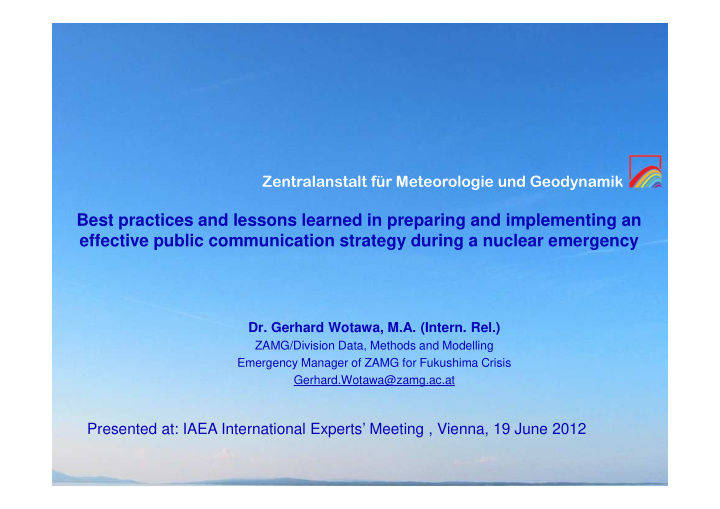



Zentralanstalt für Meteorologie und Geodynamik Best practices and lessons learned in preparing and implementing an effective public communication strategy during a nuclear emergency Dr. Gerhard Wotawa, M.A. (Intern. Rel.) ZAMG/Division Data, Methods and Modelling Emergency Manager of ZAMG for Fukushima Crisis Gerhard.Wotawa@zamg.ac.at Presented at: IAEA International Experts’ Meeting , Vienna, 19 June 2012
Topics 27.11.2012 Page 2 • Basic principles of dealing with an accident of emergency • Lessons learned from the Fukushima crisis • Ways forward Zentralanstalt für Meteorologie und Geodynamik
Basic Principles 27.11.2012 Page 3 In the world of the 21 st Century, anything serious happening in any part of the world does matter for all other countries, and for the whole international community • This is certainly true for all events having potential health impact • The radius of impact does not matter. A transboundary nature of the event is not required • Effective communication at regional, national and international level indispensable part of response Zentralanstalt für Meteorologie und Geodynamik
What was done in Austria? 27.11.2012 Page 4 • Transport of Radioactivity over Japan calculated and published • Daily meteorological assessments for crisis region published • Radionuclide Data from CTBTO used for situation assessment and useful data published • Source term estimate performed and published • At request of WMO, provided on-site support for IAEA at IEC • As part of WMO, took part in the international coordination process after accident Zentralanstalt für Meteorologie und Geodynamik
Transport of radionuclides 27.11.2012 Page 5 • Transport towards Tokyo area (March 14/15) predicted • Arrival of plume at U.S. West Coast (17/18 March) predicted Zentralanstalt für Meteorologie und Geodynamik
Source estimate 27.11.2012 Page 6 • As first institution, ZAMG published a source estimate of radionuclides released in Fukushima (22 March 2012) • The source estimate was based on a few CTBTO measurements, but accurate within a factor of 5 Zentralanstalt für Meteorologie und Geodynamik
Lessons learned 27.11.2012 Page 7 • ZAMG results were widely accessed (large download volume from Japan and USA) • Publication did not cause adverse effects, but rather helped filling information gaps • Significance of CTBT was demonstrated • New form of cooperation between international organizations established • Importance of internal information provision and exchange demonstrated (e.g., regarding travel advisories) Zentralanstalt für Meteorologie und Geodynamik
Consequences of missing information 27.11.2012 Page 8 • Rumors develop, particularly through social networks • Mistrust and exaggerated fear • Non-governmental actors fill information gaps Zentralanstalt für Meteorologie und Geodynamik
Ways forward 27.11.2012 Page 9 • Rapid assessment of nature and severity of the accident • Access to detailed information for non-accident states • Emergency procedures should include communication with other governments and international organizations • Include public information and communication in the emergency planning phase Zentralanstalt für Meteorologie und Geodynamik
Ways forward (2) 27.11.2012 Page 10 • Fast and open access to all relevant information for NGOs and the general (global) public • Globally harmonized radionuclide measurements and emergency database • Strengthen role of the IAEA during crisis situation Zentralanstalt für Meteorologie und Geodynamik
Recommend
More recommend